#hugues de france
Text
Constance d'Arles: resilient and determined
Hugh Capet, unsuccessful in his search for a Byzantine princess, arranged for his son Robert "the Pious" (so named for later acts of piety, rather than marital fidelity) to marry Rozala, the daughter of Berengar II of Italy and Countess of Flanders from her first marriage. She was considerably older than Robert, who divorced her within one year of his father's death. He had been living openly with Bertha of Burgundy (d.1035), Countess of Burgundy, and also a widow. However, Bertha was Robert's cousin: Pope Gregory V refused to sanction their marriage on the grounds of consanguinity, and excommunicated Robert. Robert repudiated Bertha around 1004; she remained unmarried and a force to be reckoned with.
In 1001, Robert married Constance of Arles (d.1034). She was a formidable, ambitious woman and their marriage, unsurprisingly, was difficult. Bertha's family opposed her, and Robert's advisors despised Constance because she favored southern customs and her Provençal family. When Hugh of Beauvais, close advisor to the king, suggested that Robert repudiate her in 1007, he was murdered by knights of Constance's kinsman, perhaps at her order. Her ambitions alienated the chroniclers of her day, who blamed her for several of the king's decisions and accused her of outrageous actions. In the account of a heresy trial of her former confessor, Constance struck out his eye with her staff. In 1010, Robert went to Rome, accompanied by his former wife Bertha, to seek permission to divorce Constance and remarry Bertha. His request was denied, he returned to Constance and together they had several children, with and against whom she plotted revolt against their father. At Constance's urging, their eldest son, Hugh Magnus, was crowned co-king with his father in 1017; after Hugh's death in 1025, Robert and Constance quarreled over which of their surviving sons should inherit. Despite his mother's protests, their second son, Henri, was crowned in 1027. Fulbert of Chartres wrote in a letter that he was frightened away from the consecration of Henri "by the savagery of his mother, who is quite trustworthy when she promises evil." Constance continued to encourage her sons to rebel, Robert agreed to their demands, and made peace until his death in 1031. Soon after that, Constance was at odds with both sons, Henri and Robert; she seized her dower lands and refused to surrender them to Henri's wife, Anna. Henri fled to Normandy, where he received aid, weapons and soldiers from his brother, returning to besiege their mother. However, Constance, ever wily and resilient, escaped, surrendering only when Henri swore to slaughter all the inhabitants of a town.
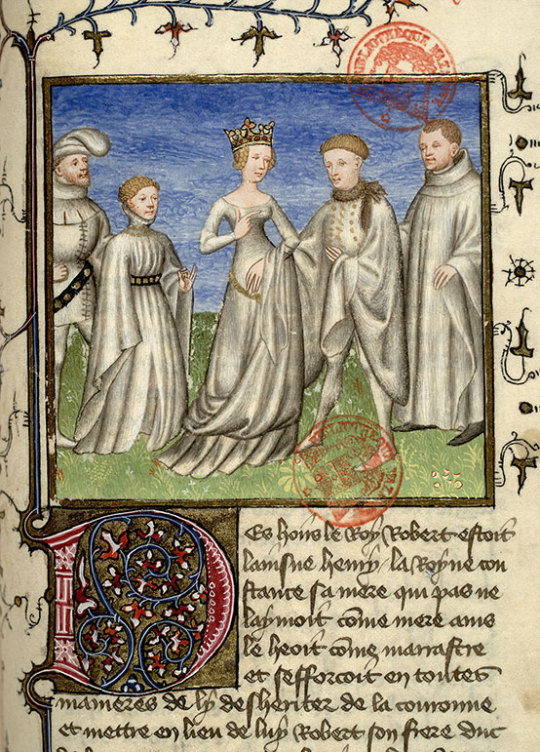
Despite this litany of malicious actions, contemporary critics of Constance also comment favorably on her concern for the royal treasury and her wise counsel to her husband. Her Provençal "foreignness" isolated her, and she struggled to balance her allegiance to both her natal and marital family. Seen in this light, many of her more notorious actions can be attributed to the absence of familial support and very real fears of repudiation. Penelope Adair argues convincingly that, given the limited resources at hand, Constance's efforts to preserve the royal treasury and her objections to alienation of royal property were "the well-founded concerns of a clear-sighted and determined royal consort."
Theresa Earenfight - Queenship in Medieval Europe
#x#xi#theresa earenfight#queenship in medieval europe#constance d'arles#bosonides#hugues capet#robert ii#rozala d'italie#berthe de bourgogne#hugues de beauvais#hugues de france#henri i#robert de bourgogne#fulbert de chartres#anne de kiev
1 note
·
View note
Text

Betty Blue (1986). A lackadaisical handyman and aspiring novelist tries to support his younger girlfriend as she slowly succumbs to madness.
While this film is just soaked in masculine fantasy, I still enjoyed the first half as a depiction of a manic romance, particularly Béatrice Dalle's magnetic performance as the titular Betty, but good lord, if it doesn't let itself down in the final act where it pivots from sexist to outright misogynistic. The end of Betty's arc left me pretty furious, and I feel would likely colour any repeat viewing of it. Just - - yeah. Not Good. 4/10.
#betty blue#1986#Oscars 59#Nom: Foreign Film#Jean-Jacques Beineix#philippe djian#jean-hugues anglade#beatrice dalle#gerard darmon#consuelo de haviland#france#french#writers#mental health#road trip#4/10
11 notes
·
View notes
Text
Billet spécial n°2 - Les imprimeurs de Lyon
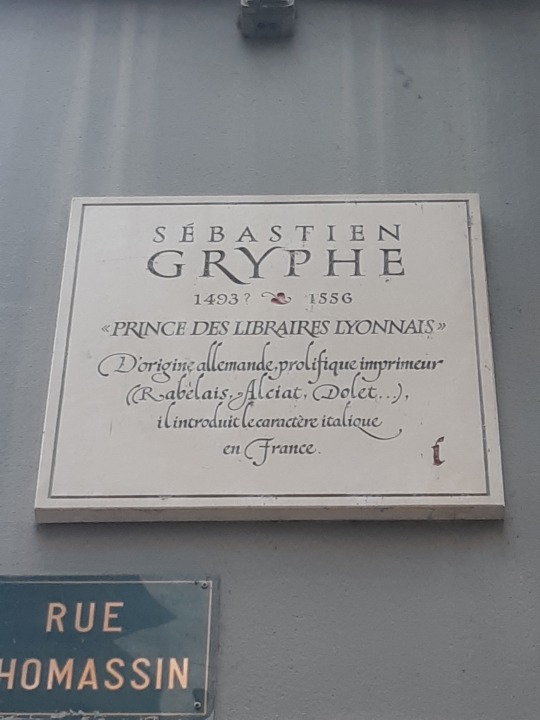



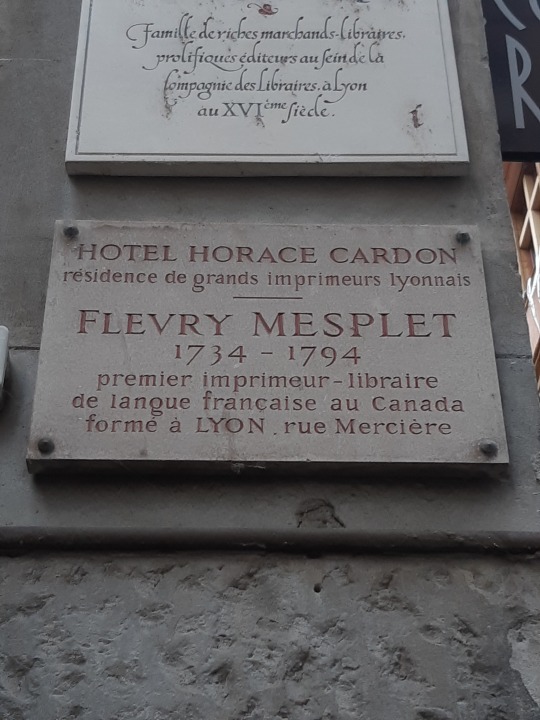
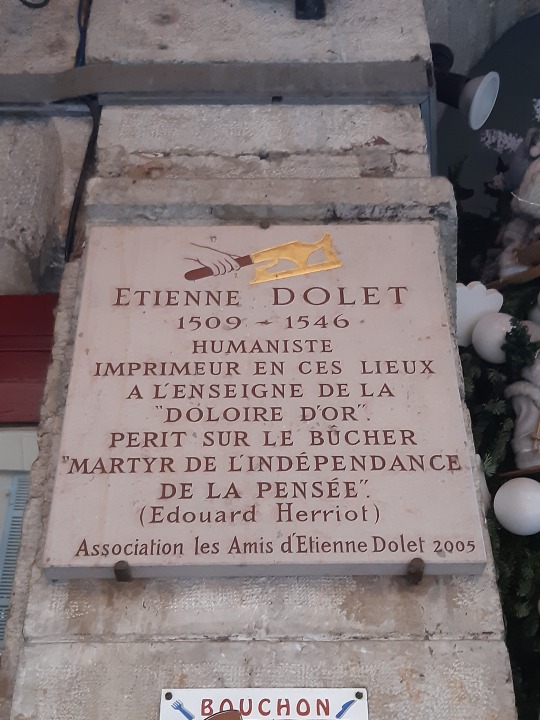
Le 300ème billet de ce blog est l'occasion d'un nouveau billet spécial. Quittant la capitale où sont situées l'essentiel des plaques commémoratives présentées ces derniers jours, il est l'heure de retourner dans une ville française également importante : Lyon.
De tout temps depuis sa fondation, Lyon a joué un rôle majeur dans l'histoire de France. Les XVème-XVIème siècles sont ainsi l'occasion pour Lyon de devenir l'un des principaux centres européens de l'imprimerie : finalisée en 1453, l'invention gagne Lyon en 1472 et lui confère une importance majeure dans le domaine de l'édition. Bénéficiant d'une politique fiscale favorable et du carrefour commercial qu'occupe Lyon, véritable ville de foires, une centaine d'ateliers d'imprimerie se concentrent notamment autour de la rue Mercière (2ème arrondissement). L'histoire de l'imprimerie lyonnaise n'est toutefois pas sans heurts : le "grand tric" de 1539, première grève de l'histoire de France, voit se révolter les ouvriers typographes qui protestent contre leurs conditions de travail et de rémunération. Il est le signe précurseur d'un déclin qui s'amorce dans les années 1560 (un siècle plus tard, l'industrie subsiste, mais se tourne surtout vers la contrefaçon).
Plusieurs plaques commémoratives (dont une partie a été installée sur l'initiative de Régis Neyret) honorant de célèbres imprimeurs lyonnais peuvent aujourd'hui être trouvées dans la rue Mercière et ses environs (les quatre premières ont été apposées en décembre 2014) :
Sébastien Gryphe (1492-1556) est un imprimeur français d'origine allemande. Produisant surtout des traités administratifs, juridiques et religieux, il est le principal premier utilisateur des caractères italiques dans les années 1530. Il publie également les œuvres de François Rabelais, étant très proche du milieu humaniste. Surnommé le "Prince des libraires", il laisse un héritage important à Lyon. Texte de la plaque (21 rue Thomassin) : SÉBASTIEN GRYPHE, 1493 ? -1556. "PRINCE DES LIBRAIRES LYONNAIS". D'origine allemande, prolifique imprimeur (Rabelais, Alciat, Dolet...), il introduit le caractère italique en France.
Mathieu Husz (1455-1507) est un imprimeur allemand qui s'établit à Lyon. Il imprima de nombreux manuels théologiques, des ouvrages juridiques et des livres sur la construction. Texte de la plaque (9 quai de la Pêcherie) : MATHIEU HUSZ. D'origine allemande, il édita la GRANT DANSE MACABRE, 1499, où l'on voit la première représentation imprimée d'un atelier d'imprimeur-libraire.
Jean de Tournes I (1504-1564) s'est formé auprès de Sébastien Gryphe. Il édite de très nombreux ouvrages de poésie d'auteurs lyonnais, dont ceux de Louise Labé, ainsi que des traités d'architecture. Il décède des suites de la peste, mais son fils, Jean de Tournes II se fait également imprimeur et fondra une grande dynastie de libraires. Texte de la plaque (7 rue Jean de Tournes) : JEAN DE TOURNES 1er, 1504-1564. Premier d'une dynastie d'imprimeurs lyonnais, reconnu pour la qualité et la beauté de ses publications, il collabora souvent avec le célèbre graveur BERNARD SALOMON.
Aymon, Hugues (1500-1572) et Sibylle de la Porte étaient trois membre d'une influente famille de marchands libraires. Hugues, fils d'Aymon et père de Sibylle, fut plusieurs fois conseiller-échevin de Lyon et l'un des plus riches libraires de Lyon, apportant un soutien financier à Sébastien Gryphe. Texte de la plaque (68 rue Mercière) : AYMON, HUGUES & SIBYLLE DE LA PORTE. Famille de riches marchands-libraires, prolifiques éditeurs au sein de la Compagnie des Libraires, à Lyon au XVIème siècle
Fleury Mesplet (1734-1794) est un imprimeur québecois d'origine française. S'étant formé au métier d'imprimeur à Lyon et après un bref passage à Avignon, il s'établit au Canada, où il fonde La Gazette littéraire, premier journal de Montréal et premier journal exclusivement en français du Québec. Texte de la plaque (68 rue Mercière) : Hôtel Horace Cardon, résidence de grands imprimeurs lyonnais. Fleury Mesplet, 1734-1794, premier imprimeur-libraire de langue française au Canada formé à Lyon, rue Mercière
Étienne Dolet (1509-1546) est un imprimeur mais également écrivain et philosophe français. Établi à Lyon, humaniste et critique du christianisme de son époque, il édite nombre d'ouvrages jugés hérétiques, ce qui lui vaut arrestations et emprisonnements, pour être finalement exécuté sur le bûcher à Paris, devenant après sa mort un symbole de la libre-pensée. Texte de la plaque (56 rue Mercière) : Etienne Dolet, 1509-1546, humaniste, imprimeur en ces lieux à l'enseigne de la "Doloire d'or". Périt sur le bûcher. "Martyr de l'indépendance de la pensée". (Edouard Herriot)
#special#oeuvre#france#rhone#lyon#sebastien gryphe#etienne dolet#jean de tournes#mathieu husz#fleury mesplet#hugues de la porte
0 notes
Text
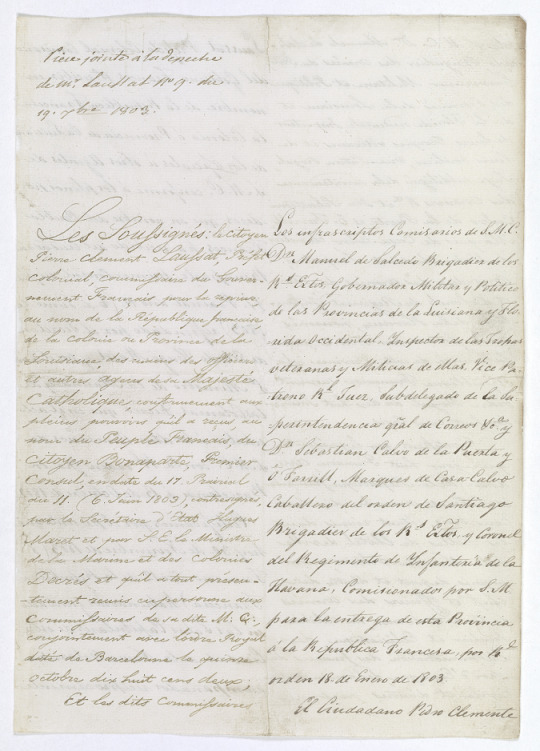
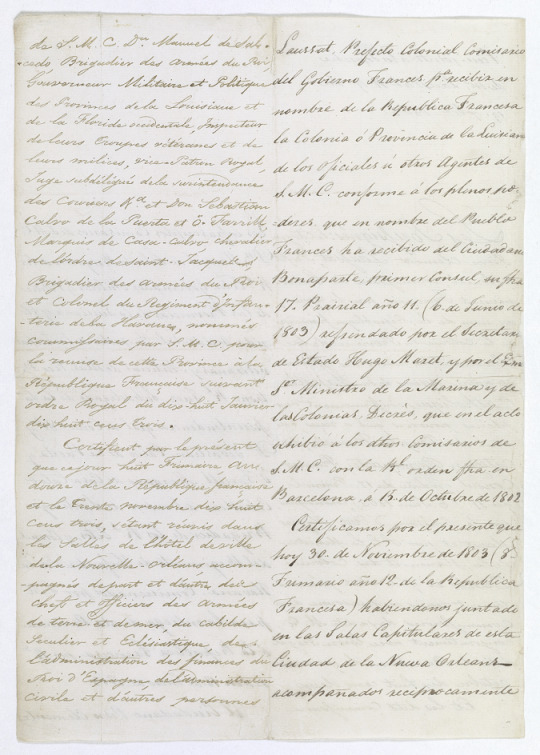

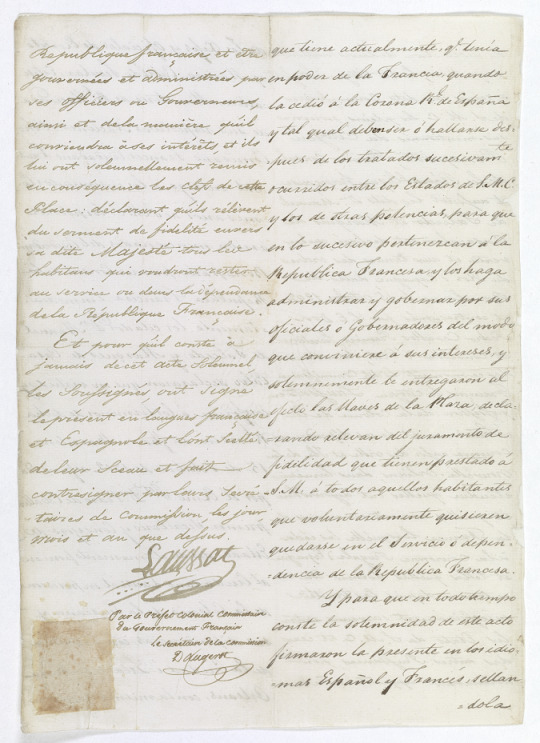
Original Protocol of the Delivery of Louisiana by Spain to France, at New Orleans on November 30, 1803
Record Group 11: General Records of the United States GovernmentSeries: Perfected TreatiesFile Unit: TS 86 AO: Treaty for the cession of Louisiana - English and French texts
[Handwritten] Pièces jointes à la depeche de Mr. Laussat n[']o 9. du 19. 7bre 1803. [Main body of document follows; French-language text on the left; Spanish-language text on the right (this pattern continues throughout the body of the document).] [French text follows -- first:] Les Soussignés : le citoyen Pierre Clement Laussat, Préfet colonial, commissaire du Gouvernement Français pour la reprise, au nom de la République Française, de la colonie ou Province dela Louisiane, des mains des officiers et autres agens desa Majesté Catholique, conformement aux pleins pouvoirs qu'il a reçus, au nom du Peuple Francais, du Citoyen Bonaparte, Premier Consul, en date du 17. Prairial an 11. (6. Juin 1803), contresignés, par le Secrétaire d'Etat Hugues Maret et pour S. E. le Ministre de la Marine et des Colonies Decrés et qu'il a tout présentement remis enpersonne aux Commissaires de sa dite M. C., conjointement avec l'ordre Royal daté de Barcelonne le quinze Octobre dix huit cens deux; Et les dits Commissaires [Spanish-language text follows (on right on original sheet/image):] Los infrascriptos Comisarios de S.M.C. D[']n. Manuel de Salcedo Brigadier de los R[']s Extos,.Gobernador Militar y Politico de las Provincias de la Luisiana y Florida Occidental, Ynspector de la Tropas veteranas y Milicias de ellas, Vice Patrono R[']l Juez, Subdelegado de la Superintendencia g[']ral [with tilde over the "r"] de Correos y c.[']a [?] y D[']n. Sebastian Calvo de la Puerta y O Farrill, Marques de Casa-Calvo Caballero del orden de Santiago Brigadier de los R[']s Ex[']tos, [with tilde over the "t"] y Coronel del Regimento de Ynfantería de la Havana, Comisionados por S.M. para la entrega de esta Provincia á la Republica Francesa, por R[']l. orden 18.. de Enero de 1803. El Ciudadano Pedro Clemente [full transcription at link]
35 notes
·
View notes
Text
Contemporary descriptions of the dantonist execution compilation
Their trial was over around one o’clock in the afternoon. Only Luiner was acquitted. But as he was detained as suspect for the sake of general security he was escorted to the Luxembourg. The fifteen others were sentenced to death, and driven to the scaffold around six o’clock. They were in three tumbrils: in the first was Danton, next to Delacroix; Fabre near the executioner; Hérault opposite Chabot. In the second, Phelippeaux [sic], Westermann, Camille Desmoulins, Basire and Launai d’Angers [sic]. In the last tumbril, one saw but l’Abbé d’Espagnac; his companions were almost all strangers and little known to the public. Almost all approached death with the same audacity that they had shown in court. Danton, who, like Hébert, was recognizable by his red collar, seemed to pay little attention to the crowd around him: he was chatting with Lacroix and Fabre. Hérault was the quietest. Chabot pointed to the sky, laughing. Desmoulins spoke almost continually to the people; the courage he affected seemed like a painful effort, he was an actor who was studying to play his last part well. Diederichsen, danish lawyer, was executed first, the heads of Lacroix and Danton were the last ones to fall. Only that of Danton was shown to the people, among prolonged cries of ”vive la république.”
Suite du Journal de Perlet, number 561 (April 6 1794). A shortened version of this description is given in number 104 of Journal général de la guerre (April 13 1794). According to Michel Biard’s La Liberté ou la mort: mourir en deputé 1792-1795 (2015), these were the only contemporary journals that mentioned any details regarding the execution.
Camille had made incredible efforts to tear herself away from these execrable gendarmes, who have been the lowest servants of despots; so that in going to the scaffold he was completely naked to the waist, because his shirt was in tatters. I saw him cross the space of the palace at the Place de Sang (that's what I called Place de la Révolution) with a frightened air, talking to his neighbors with great agitation, and yet on his face was the convulsive laughter of a man who no longer has his head.
Dictionnaire neólogique des hommes et des choses, volume 2, page 480 (1799) by Louis Abel Beffroy de Reigny. In his Testament d’un électeur de Paris (1795) Beffroy adds that he couldn’t restrain his tears in watching Camille pass by.
I saw the tumbrils pass by to the place of execution, containing the men who, a few days before, had been seen as those who were to consolidate the revolution. Some maintained a firm and calm demeanor, others only showed on their faces that humiliating vexation felt by a scoundrel who finds himself caught in the trap set up by his enemy. This feeling was depicted with the most striking expression on the decomposed countenance of Danton. Camille Desmoulins seemed indignant at the deceit of Robespierre, who had never showed him more friendship than on the eve of his arrest. Bazire and Chabot tried to speak to the people by whom they were surrounded; though they spoke loudly, the noise which was made around them drowned out their voices. One only heard them say that, had not Marat been assassinated, he would have been accused of conspiracy like them, and that with them he would go to his execution. The multitude regarded as blasphemous an assertion of which the truth, a few days later, was disputed by no one. They were executed on 17 germinal.
Histoire Philosophique de la Révolution de France (1807) by Antoine Étienne Fantin-Desodoards, volume 5, page 371-372
Like Hugues Aubriot, who was imprisoned in the Bastille he had had built in order to trap others, when Danton had been condemned to death by the tribunal he had instituted, the crowd gathered in the square to feast their eyes on the horrible spectacle that the cries of the public promised them.
I was going to see Méhul, who was by then living on Rue de la Monnaie, when I came across the tumbril in Rue Honoré in which this revolutionary hero was for the last time presiding over his stricken party. He was calm, between Camille Desmoulins, whom he listened to, and Fabre d'Églantine, who did not listen to anyone. Camille spoke with great warmth, and struggled so much that his unfastened clothes left his collar and shoulders, which the blade was about to separate, bare. Never had life manifested itself in him by more activity. As for Fabre, immobile under the weight of his misfortune, overwhelmed by the feeling of the present and perhaps also by the memory of the past, he no longer existed. Camille who, by cooperating in the revolution, had thought he was cooperating in a good work, still enjoyed his illusion; he believed himself on the road to martyrdom. Alluding to his last writings, he shouted: “My crime is to have shed tears!” to the crowd. He was proud of his conviction. Fabre was on the other hand ashamed of his, he, who had been pushed into revolutionary excesses by less generous interests, was overwhelmed by the awareness of the truth. He saw only torture at the end of the little road that remained for him to travel.
Another physiognomy also attracted my attention in this cartload of reprobates, it was that of Hérault de Séchelles. The tranquility which reigned over the handsome face of this former advocate-general was of a different nature from the tranquility of Danton, whose face offered a caricature of that of Socrates. Hérault's calm was that of indifference; Danton's calm that of disdain. The pallor did not sit on the latter's forehead; but that of the other was colored with such a fiery tint that it looked less like he was going to the scaffold than returning from a banquet. Hérault de Séchelles finally seemed detached from life, the preservation of which he had purchased by so much cowardice, by so many atrocities. The appearance of this selfish man astonished everyone: everyone asked his name with interest, and as soon as he was named he no longer interested anyone. […] I went up to Méhul's, and, my imagination full of what I had just seen, I told him: “Tragedy well begun! I want to see the end of it, after having finished in three words the business which brought me. This Danton really plays his role well. We are all on the eve of the day that will end for him. I want to learn how to pass it well too.” "Useful study," said Méhul, who saw things with the same eye as me, and who would have accompanied me if he hadn't been in his dressing gown and slippers.
However, the fatal tumbril had not stopped moving; the execution was beginning when, after having crossed the Tuileries, I arrived at the gate which opens onto the Place Louis XV. From there I saw the condemned, not mounting together, but appearing one by one on the fatal scaffold, to die immediately by the effect of the movement which the board or the bed on which was about to begin for them the eternal rest. The rest of the operation was hidden from me by the operatives running it. The accelerated fall of the blade alone told me that it was was being carried out.
Danton appeared last on this scene, flooded with the blood of all his friends. Day was falling. At the foot of the horrible statue whose mass stood out in a colossal silhouette against the sky, I saw the rising, like a shadow of Dante, of this tribune who, half-lit by the dying sun, seemed as much to emerge from the tomb as ready to enter it. There is nothing as daring as the countenance of this athlete of the revolution; nothing as formidable as the attitude of this profile which defied the axe, like the expression of this head which, ready to fall, still seemed to dictate laws. Horrible pantomime! time cannot erase it from my memory. I found there all the expression of the sentiment which inspired Danton with his last words; terrible words which I could not hear, but which people repeated to each other, quivering with horror and admiration. ”Above all, don't forget,” he said to the executioner with the accent of a Gracque, don't forget to show my head to the people; it’s worth seeing.” At the foot of the scaffold he had said another word worthy of being recorded, because it characterizes both the circumstance which inspired it, and the man who uttered it. With his hands tied behind his back, Danton was waiting his turn at the foot of the stairs, when his friend Lacroix, whose turn had come, was brought there. As they rushed towards each other to give each other the farewell kiss, a policeman, envying them this painful consolation, threw himself between them and brutally separated them. "At least you won't prevent our heads from kissing each other in the basket," Danton told him with a hideous smile. Danton, as I have said, perishes as a result of a security more justified by reason than by politics. Warned of Robespierre's plans, Robespierre knows too well that he cannot send me to the scaffold without proving that he can be sent there himself." Resting on this idea, he fell asleep in laziness and pleasures.
Souvernirs d’un sexagénaire (1833) by Antoine Vincent Arnault, volume 2 page 95-100. According to Biard in Danton: Le mythe et l’histoire (2016) this is the only semi-authentic source we have for Danton’s last words being ”show my head to the people, it’s worth seeing.” It’s still however somewhat dubious considering Arnault places Camille in the wrong tumbril.
#happy deathday dantonists!!#camille desmoulins#fabre d’eglantine#pierre philippeaux#herault de sechelles#and everyone else who was executed tbh#yes even you unknown danish lawyer#french revolution#frev#frev compilation#george danton#danton#did i seriously forget to add a Danton tag…
57 notes
·
View notes
Text
The mayor of a small French town in central-eastern France has been detained after police said 70kg (154lb) of cannabis was found in her home.
Police said it had also discovered about 1kg of cocaine, €7,000 euros (£5,991) in cash and gold bars.
Jamilah Habsaoui, the mayor of Avallon, and two of her brothers were among seven people arrested earlier this week, the public prosecutor said.
Ms Habsaoui's lawyer denied that she knew the drugs were stored at her home.
The mayor's house, the town hall, and the pharmacy whereMs Habsaoui workedwere all searched, prosecutor Hugues de Phily told AFP news agency.
Mr Phily said her arrest on Sunday was the result of several weeks of investigations into drug trafficking in the town, which is home to 6,000 people and located in the Bourgogne-Franche-Comté region.
Ms Habsaoui was elected mayor in March 2021, after serving as a local councillor since 2014.
The lawyer for one of Ms Habsaoui's brothers told French newspaper Le Figaro that the drugs were stored at the property without the mayor's knowledge and without her consent.
In an interview with local newspaper L'Yonne Républicaine, Ms Habsaoui's lawyer said the mayor was "stunned by the discovery made in her house by the gendarmes".
Ms Habsaoui has been charged and detained pending trial along with five others, according to a statement released by the prosecutor on Thursday.
5 notes
·
View notes
Photo

HISTOIRE/ACTUALITÉ | Mythe républicain de la liberté : ferment de l’esclavage moderne ➽ http://bit.ly/Mythe-Liberte Dans son « De l’esclavage moderne » publié en décembre 1839, le père Hugues-Félicité de Lamennais, précurseur du catholicisme social, explique comment les individus constituant la majeure partie du peuple de France sont assujettis à l’inégalitaire capitalisme les tenant par la faim, à l’inique justice rappelant la lutte allégorique du pot de fer contre le pot de terre, et au joug fiscal les privant à leur décès de transmettre à leur famille le modique pécule acquis à la sueur de leur front...
#mythe#républicain#révolutionnaire#République#Révolution#liberté#égalité#fraternité#Lamennais#catholicisme#social#capitalisme#justice#fiscalité#société#droit#Histoire#actualité
5 notes
·
View notes
Text
Alter Ego of Truth and Lies: Hugues de Payens (Full Profile)
*Note that all information in this profile is subject to change at any time.
Class: Alter Ego
True Name: Hugues de Payens
Nickname: Alter Ego, Alter Ego of Truth and Lies, AERT, Hugues de Payens Prototype, Hughes de Payens, Grandmaster Hugues, The First Templar, The Most Righteous of Templars, “Big Sister/Brother,” “Mistaken Fool,” Hugues de Payns, Hugo de Paganis, Hues de Paiens delez Troies("Hugh of Payens near Troyes"), Ugo de' Pagani, Master of the Knights of the Temple
Characteristics
Species: Servant, Human
Gender: Male, Nonbinary, Female
Height: 1.72 Meters
Weight: 90kg with Armor
70kg without Armor
Blood Type: Unknown
Place of Origin: Payens, France
Birthday: 1070
Age: Unknown
Personal Information
Addresses self as: Watashi(わたし), Jibun(じぶん)
Likes: Truth, God, honesty, Knights Templar, the countryside, rustic villages, Saint Mary(the mother of Christ)
Dislikes: Lies, demons, dishonesty, rumors, hearsay, heresy, Knights Templar, secrets, undead
Talents: accounting, managing money and finances, rallying people to a cause
Natural Enemy: Hassan-i-Sabbah, Salah al-Din Yusuf ibn Ayyubn, Knights Hospitaller, and the Teutonic Knights
Image Color: Blood Red, White and Silver
Affiliations:
Knights Templar
Family Members
Thibaud(Son)
Many possible descendants
Servant Stats
Type: Heroic Spirit
Source: Legends of the Knights Templars, Historical fact, Rumors about the Knights Templars
Region: Payens, France
Alignment: Lawful Good
Hidden Attribute: Man
Armaments: Sword, mace, and shield
Known Summoning Catalysts: a sword once used by Hugues de Payens, a mace once used by Hugues de Payens, a coin from some of the money that Hugues de Payens managed, a piece of Hugues de Payen’s shield, and a fragment of Temple Midlothian.
Qualified Servant Classes
Within the prime Fate timelines AERT is an entity that split off from the original/true Hugues de Payens(Shielder Hugues de Payens Profile). They are born from a mixture of both truth and some of the rumors surrounding the Knights Templar during/after Jacques de Molay and the Templars he led were accused of and charged with practicing witchcraft and heresy. So great were these rumors that they spread like wildfire and came to affect not only Jacques de Molay but the very image of the Templars themselves. Some of these rumors are what led to the birth of this Hugues. Due to the fact that they are split off from the actual Hugues de Payens they are eligible for all the classes she is eligible for and some extra ones due to their altered mental state and some of the skills they have gained from myths and rumors. Interestingly, within the prototype timelines, this Alter Ego Hugues is the default/real one and is thus not eligible for the Alter Ego class in said timelines.
Alter Ego
This class is a natural fit for a being born from rumors that split off from the original Hugues de Payens. Their existence is a delicate one as they are constantly being pulled mentally in two separate directions. First, there is the side of Hugues and the Templars that was seen as noble, and heroic. Alongside that, there were even some myths that saw Hugues and their knights as holy or on the search for holy objects and relics. Some even believe that they found some of these objects. On the other hand, you have the corruption created by those who saw the very Templars and their entire order as corrupt and rotten with heresy and witchcraft. AERT is constantly being pulled towards either side. While they try to uphold and perform the values of their holy order the whispers of countless rumors and accusations constantly try to pull them towards being part of the corrupt order everyone “knows” they are. As if countless people want their suspicions and lies confirmed to be true. This has caused AERT to become more paranoid and to go even further to prove their devotion to God and his faith.
Saber
Many crusaders were well known for their zeal for God as well as the bravery and violence they would display in his name. As a Saber, this part is emphasized and Hugues is noticeably more aggressive and offensive in their close combat fighting style. This is reflected in how Hugues has the Valor skill in this form. This form of Hugues is affected by the more exaggerated and fantastical tales of the Templars than the Saber form of the other Shielder Hugues. In this form, AERT is also unaffected by the rumors that burden the Knights Templar. They also have a Noble Phantasm based on the flag of the Templars. There was a rule that stated no warriors of the Templars should ever surrender unless the Templar flag had fallen, and even then they were to try to regroup with another one of the Christian orders first, such as the Hospitallers. It was only after all the flags had fallen that they were allowed to leave the battlefield. As a Noble Phantasm, this flag makes Hugues and any Knights Templar within its range unable to die until the flag is either destroyed or falls, or until Hugues runs out of mana.
Rider
The crusades were massive war campaigns in the name of God and the holy land. This fact is epitomized when Hugues is summoned in this form. They specialize less in one on one combat and more on directing and summoning large armies.
Berserker
It is well known that the crusades were quite violent. Despite how many crusaders felt like they were fighting for a holy cause, it is unsurprising that during battle many of them would have been overtaken by anger or embraced rage. With some believing their anger to be the wrath of God or striving to be the embodiment of God's wrath on the battlefield. In this form Hugues has access to a version of the Noble Phantasm Deus Vult: The Rallying Dream of the Crusaders. But it acts slightly differently, as the Noble Phantasm will not end until all of their opponents have been killed and/or defeated or Hugues and their army dies.
Shielder
This Hugues’ shielder form is somewhat different from the female one. In this form AERT specializes in defensive formations meant to protect the holy land and its faithful pilgrims. Due to this AERT takes the form of a noble protector with abilities that allow them to protect holy sites, saints and people of the same faith. However, these same abilities damage and bring drawbacks upon those of different religions, demonic entities, or those who wield black/demonic magic.
Foreigner
In this form Hugues has succumbed to the corruption of rumors and has taken on a heretical form based on the lies told about the Knights Templar. Hugues has had their form twisted by this on top of becoming possessed by an outer god. In this form they wield powerful black magic and demonic magic. It is possible that Jacques de Molay(Foreigner) has something to do with this form’s existence. Meaning that there is a chance this form can only be summoned under specific circumstances or when Foreigner Jacques is present.
Ruler
In this form Hugues’ side that follows the way of god has won out, standing above all the rumors spread about their order. The legends of the Templar finding holy artifacts has also further amplified this form’s resistance to the corruption of rumors. They are saint-like and have no wish for the grail themselves(qualifying them for this class), only wishing to observe and protect the grail and fight in the name of God.
Avenger
In this form Hugues has succumbed to the corruption of rumors and has taken on a heretical form based on the lies told about the Knights Templar. Unlike their Foreigner form, however, they are not possessed by any outer god. So they seek vengeance on all those who falsely accused and besmirched the good name of the order of the Templars through any means necessary.
Other Versions- Shielder Hugues de Payens(Shielder Hugues de Payens Profile)
Parameters
Strength: A
Endurance: B+
Agility: D
Mana: B
Luck: C+-
NP: A+
Hugues’ luck stat is odd since it has both a + and a -. What this means is that AERT’s luck is unstable and has a chance of jumping up to an effectiveness greater than that of B rank or dropping in effectiveness to a point where it is less effective than a luck stat of D. They also appear to be slower than that of the real Hugues. Their Endurance has also slightly dropped due to not being in a more defensive shielder form.
Class Skills
Magic Resistance: B++
At B rank, it is a skill that cancels spells with a chant below three verses. Even if targeted by greater magecraft and Greater Rituals, it is difficult for the user to be affected.
In the case of AERT the skill increases in effectiveness when resisting holy and/or demonic magic and magecraft.
Riding: C
At C rank, it is a skill that allows one to flawlessly manage beasts and vehicles if they have received the proper training and adjustments. Most vehicles and animals can be handled with above average skill. However, the user cannot ride the likes of Phantasmal Species such as Monstrous Beasts.
In life Hugues could ride horses quite well which has translated to having this skill.
Madness Enhancement: E-
At E rank the user does not receive the benefits of Mad Enhancement nor do they lose any of their reasoning abilities, and overall they just become a little rougher.
This would be a much higher rank if AERT was summoned as a Berserker. At this rank it does also make Hugues slightly more focused on proving faith through combat and numbs their ability to feel pain to a degree.
Personal Skills
Defense of the Faithful: C
A skill that acts as a variation of the Self-Field Defense Class Skill of the Shielder Class. Like Self-Field Defense, it protects allies and allied territory, with the skill’s range increasing the higher the rank, but unlike Self-Field Defense it only works on those who the owner deems to be faithful or shares the same religious beliefs as them.
Given that Hugues de Payens was the first Grandmaster, their desire to protect their Order´s true purpose and those who devote their life for said Order manifested as a Defensive Barrier made to protect soldiers and pilgrims alike who are faithful and wish to journey to the Holy Land.
Charisma of the First Grandmaster: B+
A skill born out of the fact that Hugues de Payens was the first Grandmaster of the Templar Order, not only were they Cofounder of the Order alongside their friend Bernard of Clairvaux, but they were considered the most capable person of leading it, being capable of proving their prowess both as a spiritual and military Leader during the 20 years they served as the Order´s Leader. They are capable of inspiring almost anyone who has joined their order to follow them. It appears that in the case of AERT the skill’s effectiveness has dropped one rank. This is due to the influence of rumors making people less trusting of the Knights Templar order in general.
Vow to Renounce Temptation: C+-
A Skill born out the vow Hugues and the other original Templars took once the Order was first created, it's a decree that states that they will renounce the world and all of its temptation, material wealth, etc. in order to attain purity in the name of God, it's a skill that shows their devotion for their cause as a Templar, being ready to renounce anything in the name of the Lord almighty. For AERT it has been lowered a rank due to their Innocent Monster skill. Making it less effective as well as less stable and more prone to fluctuations in its effectiveness.
Latin Rule: A++
A special Skill that in truth is one of the Noble Phantasms Hugues de Payens has in possession, it's described as a code of honor that all Templars had to uphold which was written by both Bernard de Clairvaux and Hugues de Payens. It describes how the Knights should behave at all times both in and out of battle, stipulating the needed punishments to be taken if it wasn't fulfilled. Innocent Monster has caused this skill to drop one tank.
Golden Rule: C
A Skill that refers to the measurement of one's fortune to acquire wealth. With this skill money will seem to find its way towards a servant.
The Templars are notable for being prominent in the field of finance and Hugues helped establish the order as a financial institution. Like their institute, Hughes is proficient at handling money which has manifested as this skill. While this skill does not guarantee they will be rich it does prevent them from accidentally becoming broke or falling into debt.
Innocent Monster: C+-
An attribute possessed by Servants whose true history and existence have been distorted by the monstrous reputations and gossips they accrued across the course of their life and thereafter, without concern for the actual person's will or appearance. As a consequence, the Servant's abilities and appearance have been rendered to conform to the specifications of their legend. Incidentally, this Personal Skill cannot be removed. Hugues is constantly fighting off the mental effects of this skill with faith so it often drops in effectiveness. This skill has a chance of rising in potency if AERT is hit with a demonic or black magic attack and will decrease in potency if hit with a holy or divine attack.
This skill can potentially affect many of the Servants in the Knights Templar due to the rumors of heresy, demonic magic, and black magic surrounding Jacques de Molay and the Templars. Hugues considers it their burden and believes that it will be dispelled once they dispel all the rumors and lies told of their order. To them it is a reminder of the shortcomings of the order and proof that either their faith wasn’t strong enough or that they didn’t perform God's will enough. It appears that the effectiveness of this skill is also tied to Hugues’ master. If said master is one of faith or believes Hugues to be one then the skill is less effective. But if they practice heretical teachings or believe the rumors about the Templars then the effectiveness of the skill will be raised.
Noble Phantasms
Liber de Laude: Praise to the Righteous Templar- Rank A(Anti-Unit (Self)), Maximum Number of targets 1~20,000
Liber de Laude, also known Liber ad milites templi de laude novae militiae which roughly translates to “Book to the Knights of the Temple, in praise of the new knighthood” is a book attested to Hugues de Payens, written by Saint Bernard of Clairvaux which served to boost the morale of all of the Templar Knights due to its tone and timing. The book was something Hugues de Payens desired to write in order to maintain the hope, faith, and morale of their Templars, but due to unknown circumstances was unable to write it themselves, thus they asked for help from their friend Bernand to write it for them, even going as far as to have asked him 3 times to write such texts for their knights. Bernard mentions in the text that it was all the idea of Hugues themself, as the text both talked about how much knighthood had fallen since the Age of Knights and how the Templars, unlike other contemporary knights, remained just and righteous, with them being the last defenders of the God almighty´s teachings, equating their crusade as a righteous journey that they must go through to achieve salvation. Despite the worries the Templars of said time had on whether their cause remained just or not, Hugues and Bernand ensured to write something to keep their morale up in order to reach their ideal of salvation.
This Noble Phantasm works by essentially rallying up the forces under Hugues’ command, essentially boosting their morale to continue fighting no matter how dire or difficult the situation may be, convincing them that their fight is a righteous one worth fighting for. Once the Noble Phantasm is activated, it would be as if Hugues read the actual book in its entirety, pointing at the flaws their current enemies possess while highlighting and glorifying all the virtues their allies possess in order to boost them for battle, giving them the belief needed to surpass any enemy as they continue their righteous crusade. Liber de Laude is capable of boosting thousands of Allies at a time, being capable of letting them face enemies that are stronger than them, and even in theory being able to make simple soldiers into fighters strong enough to contend with E Rank Servants, showing the great power and motivation the text truly possesses. But it's far from an all powerful boost as despite being capable of giving a great boost to its allies, they need to truly believe that they are capable of that for the effects of Liber de Laude to take effect, meaning that an ally with great enough Mental Pollution or an enemy with great Resistance to Mental Attacks may not be affected as easily, and also… Just like their Order, it's not a permanent boost and eventually it will fade away.
“Knights are impure savages, driven only by lust and greed
Their path of Knighthood has been tainted, lost by the Evil of Men
But thy path is still Bright oh Brethren in arms, your righteousness can still be shown
Your fearless sacrifice in the name of the Lord won't be in vain, your Holy belief shall carry you onward. So raise up your arms for Battle! Dictate your wish to fight for what is right! Fight for proof of what you truly are! FACE ALL WHO TAINT YOUR HOLY CRUSADE, REACH UNTO THE GATES OF HEAVEN! LIBER DE LAUDE!”
“HEAR THY VOICE FELLOW TEMPLARS AND PREPARE FOR BATTLE!
IT'S TIME FOR YOU TO PROVE YOUR WORTH AS A KNIGHT!
SHOW YOUR RIGHTEOUSNESS AGAINST THOSE WHO TAINT KNIGHTHOOD!
KEEP YOUR HEAD UPTIGHT AS YOUR CHARGE TOWARDS THE GATES OF HEAVEN
YOU ARE THE GUARDIANS OF THE LORD'S TEACHINGS, FIGHT TO PROVE OUR CAUSE!
LIBER DE LAUDE!”
“BURN ALL THOSE WHO DARE CALL US HERETIC!!! LET THEM HEAR OUT TENETS OF FAITH AND KNIGHTHOOD!!! LIBER DE LAUDE!!!”
Deus Vult: The Rallying Dream of the Crusaders- Rank A+(Anti-Army), Maximum Number of targets 1~1,000
This is the legendary chant used to signify the beginning of the crusade, once chanted by Pope Urban in order to trick those poor souls that would die for his ambitions now became a chant of honor and unity between all knights that made up the Templar, a single phrase “God
wills it” which became a symbol for this Holy Crusade… It’s the chant that
united so many people under one single goal. The Holy Crusades weren’t a single event that happened just once, it was a massive moment in Christian history as it saw the rise of various warriors of faith who gave their life to reclaim the Holy Land of Jerusalem as that was the promised land told by the Lord, in fact it wasn’t merely a single Crusade but various which were fought across years by different religious leaders with different amounts of success, an event that shook the Christian world by its sheer magnitude.
All of those who have led a crusade have access to this Noble Phantasm in one form or another. Despite theoretically having the same potential under all of its users, its effectiveness varies depending on how beloved they were as leaders or what crusade they led. So in truth, no two crusader kings would have the same usage of this Noble Phantasm.
Despite not being the leader of any particular crusade, Hugues de Payens is capable of calling forth for the aid of any Templar known throughout history, being able to summon any and all Templars known throughout history to aid them in battle… Summoning any future grandmaster of their order and every nameless soul who truly believed in the ideal that the Templars upheld… and in theory… they could even summon their old friend Bernard through this Noble Phantasm.
Once activated, Hugues will be able to manifest the world where their crusade took place, being able to summon all the different crusaders that fought at her side as Phantoms of humans who lost their name in history, while they lack any sort of skill and class the sheer
numbers that they possess makes them capable of overwhelming even the strongest of servants for a limited amount of time.
Of course, the crusaders summoned are just as strong as humans, so they aren’t hard to get rid of, but their conviction makes them continue fighting even at the brink of death, in some special cases it’s possible for a few to manifest as actual historical figures that have fought in the crusades, but they lack access to their skills and Noble Phantasms. But as expected, such a Noble Phantasm requires a great amount of mana to be used, and in most cases can only be used once per battle before Hugues is forced to squeeze their master out of all the magical energy they possess… Also, this Noble Phantasm, while strong against individual servants, is far from perfect as techniques which have massive areas of destruction, such as many anti-fortress and some anti-army Noble Phantasms, would be capable of wiping out the entire Crusade in mere seconds.
AERT’s version of this Noble Phantasm varies slightly from that of the actual Hugues as they are capable of summoning even fictional Templars as long as enough people believed them to have existed at some point. Furthermore, it gains an increase in effectiveness when it is used to attack someone/something with demonic magic/objects and those wielding holy objects. While the crusade stomps out anything it sees as heretical it is also enhanced by the legends of the Templars searching for and obtaining holy artifacts. If the Noble Phantasm is targeting someone with a demonic object the onslaught of the army will refuse to stop until every soldier has died or the demonic object has been destroyed. If Deus Vult is used to kill someone with a holy object or relic the Noble Phantasm will basically “steal” it. Allowing Hugues to use it as a Noble Phantasm of their own. If this holy object happens to be the Noble Phantasm of another servant it will transfer to AERT with no degradation in rank, effectiveness, or quality.
“IT'S TIME FOR YOU TO RAISE UP YOUR ARMS ONCE MORE!
WE FIGHT FOR GOD'S GLORY, WE FIGHT FOR SALVATION AND THE LIGHT OF TOMORROW! WE SHALL GRACE THE HEAVEN AND REACH OUR RIGHTEOUS PLACE
FOR THE GLORY OF GOD, TO HONOR KING SOLOMON, HEAR THY CALL OH HOLY TEMPLARS DEUS VULT!”
“Our crusade JUST, our faith PURE, or wrath HOLY. Now show all those non-believers just what I am referring to! DEUS VULT!!!”
“IF GOD WILLS IT THEN WHO AM I TO DENY IT!? DEUS VULT!!!”
“This will be a crusade to cleanse the land… DEUS VULT!!!”
Ignea Veritas et Fides: Burn Away the Heretic, the Liar, and the Non-Believer- Rank C(Anti-Unit), Maximum Number of targets 1~10
A manifestation of the more fanatical side of the crusades and the Templars to punish the non-believers and the heretics,
It takes the form of a cleansing flame that coats anything Hugues is holding that they recognize as a weapon. These flames will burn all those who do not believe in the Christian faith or those who practice heretical teachings, such as witchcraft or demonic magic. It is harmless to the likes of true saints or the faithful though. If the fire burns someone who is not on the level of a servant they will be burnt to ash in mere moments. Entities such as servants who are burnt by the flame will feel it and continue to do so until they become a believer of the Christian faith and renounce their heretical ways or until Hugues dies. This also applies to non-servants if they manage to survive through some outside aid or miracle.
This Noble Phantasm also works the same way against existences that are considered “unholy” such as zombies, vampires, and Dead Apostles.
Unfortunately, the partially corrupted state Hugues de Payens takes in their Alter Ego form means that they feel a burning sensation in the parts of their body that have been too corrupted as long as they are using this Noble Phantasm. AERT sees this pain as a test of faith though.
The Noble Phantasm also burns those who are actively lying. This also means Hugues themselves cannot tell a lie while using this ability lest they burst into flames. This Noble Phantasm burns a hotter blue if used within a church or anywhere sufficiently holy.
“As God wills, I will make sure you burn for your deeds! IGNEA VERITA ET FIDES!!!”
“Sinners like you must be punished. IGNEA VERITA ET FIDES!!!”
Secans Mendacium: The Blade of Burning Falsehood- Rank B-(Anti-Unit), Maximum Number of targets 1~10
All the rumors and assumptions people had towards the Knights Templar have coalesced into the physical form of a large strange living cursed sword composed of Phantoms, Wraiths, and rumors. Whenever Hugues wields this sword their Innocent Monster increases by one rank and their Vow to Renounce Temptation decreases by one rank. When used it also pushes them closer to a Templar that all the rumors and lies said the order was. The sword also seems to physically corrupt Hugues every time they unleash its True Name.
The sword constantly whispers to Hugues, beckoning them to worship demons and unleash its True Name. The sword also whispers to those near Hugues and attempts to corrupt those that touch it. So Hugues must remain vigilant and faithful. When the true name is unleashed the sword is bathed in a demonic hellflame that whispers lies and rumors as it burns. This flame is then unleashed in the form of a fiery slash at its target. Those who are hit by the flame will be inflicted with visions and whispers of all those who hate them and all the negative things that the world believes about them. If a servant doesn’t have a strong enough protection to mental attacks they can end up turning into an alter form of themselves if they fail a luck check.
Every time Hugues unleashes this sword’s true name the grip of rumors upon their form becomes stronger and stronger. If AERT uses this Noble Phantasm’s true name more than 6 times then they will be transformed into an alter and lose the “grace of god.” Becoming the heretical knight of witchcraft and demonic magics that many believed the Templars were.
Hugues’ left arm appears to be physically corrupted and weirdly thin and purple. When Hugues wields their Secans Mendacium Noble Phantasm that arm becomes unnaturally muscular. The corruption can be seen trying to spread throughout their body in a vein or root-like fashion. It appears to grow in strength and size whenever Hugues uses Secans Mendacium.
“Please God, have mercy on my soul. SECANS MENDACIUM!!!”
“I am sorry God. I can only ask for your forgiveness. SECANS MENDACIUM!!!”
“If that is what you think the Templars are then FINE. SO BE IT!!! SECANS MENDACIUM!!!”
“I’m sorry my lord God, but I need to win this fight. SECANS MENDACIUM!!!”
Miscellaneous Skills, Abilities, and Equipment
They are trained in the ways of the Church and are extremely proficient with using things like black keys and scriptures in combat. This gives them an edge when fighting the undead and/or unholy as well as other spirits.
They wield a sword that is smaller than their Noble Phantasm. They often use this as their main weapon instead of their Noble Phantasm due to said Noble Phantasm’s corruptive influence. They also wield a special flail for longer ranged combat. It can also physically hit and bind spirits.
The flail is a relic that has been blessed and is extremely effective against demonic and undead entities, such as Dead Apostles and vampires.
They also wield a large shield. There’s nothing particularly special about it except for the fact that it is blessed with special wards and tougher than any normal shield.
They always seem to smell of burning incense.
They seem to have some sort of odd connection with the proper Hugues and can sometimes recall events she experienced of people she has met.
Background
AERT’s true identity is that of Hugues de Payens, the co-founder and first Grand Master of the Order of the Templar Knights, the most famous order of Knights during the Holy Crusades. However, while this form of Hugues is real in the prototype universe in the normal timeline they are not the real Hugues(Shielder Hugues de Payens Profile). Instead they are an entity that split off from her in the form of an Alter Ego born from a mix of fact and the rumors/hearsay regarding the Knights of Templar. While some were good, many of the rumors that Hugues was born from regard how the last Grand Master, Jacques de Molay, apparently practiced witchcraft, black magic, and heresy. While this would normally only affect Jacques the rumors involved the very Templars themselves, causing its corruption to seep into many different forms of members of the Knights Templars.
AERT shares almost all of the same background as the figure they sprung from. Not much is known about Hugues de Payens' life as there isn't any account that serves as a Bibliography of their life. Most of their early years were surrounded in mystery, with historians barely getting somewhat of a time period where they were born given that in the year 1085–1090 Hugues was a witness to a donation by Count Hugh of Champagne in a document, at that point they must have been at least 16 years of age which at that time meant they was a legal adult in order to be a witness of such a document, meaning that they would have been born no later than the Year 1070. While there weren't many documents directly mentioning Hugues, the most famous attestment to their name came from the fact that they were the co-founder and subsequent first Grand Master of the Templar Order of Knights. It was said that Hugues de Payens went on a pilgrimage to the Land of Jerusalem alongside Hugh, Count of Champagne around the year 1104-1107 but while the count had then returned to France Hugues had stayed in the Holy Land as there were future documents that refer to them with the title of "Master of the Knights of the Temple", but the Templars themselves are said to have originated much earlier than that. The chronicler Simon de St. Bertin wrote that Hugues de Payens approached King Baldwin II of Jerusalem (whose reign began in 1118) alongside Bernard of Clairvaux and eight other knights, two of whom were brothers and all of whom were his relatives by either blood or marriage, in order to form the Order of the Knights Templar. The other knights were Godfrey de Saint-Omer, Payen de Montdidier, Archambaud de St. Amand, André de Montbard, Geoffrey Bison, and two men recorded only by the names of Rossal and Gondamer. Baldwin approved the foundation of the Order and entrusted the Temple of Jerusalem to its care. Count Hugh of Champagne himself joined the Knights Templar on his third visit to the Holy Land in 1125. As Grand Master, Hugues de Payens led the Order for almost twenty years until their death, helping to establish the Order's foundations as an important and influential military and financial institution. On his visit to England and Scotland in 1128, he raised men and money for the Order, and also founded their first House in London and another near Edinburgh at Balantrodoch, now known as Temple Midlothian. He also helped develop the famed Latin Rule which served as the first set of rules of conduct for the Order.
At some point Hugues encountered and fought one, and possibly more, of the Hassan-i-Sabbah during one of the crusades they took part in. They have only ever managed to get the Hassan to retreat and wounded one by cutting off one of their limbs. However, they have yet to kill a Hassan.
Some legends surrounding the Templars perpetuate the idea of the order having a mysterious nature. Claiming that the Knights Templar excavated a sacred treasure from the ruins of Solomon’s Temple. Which according to the rumors prompted them to go to Rome in 1127. However, there is little evidence backing up these claims.
Eventually, on an unknown date Hugues had died… the details regarding their death are scarce and no source seems to agree on the reason why they ended up perishing, and it seemed that with their death, the Templar Order began deteriorating more and more as it slowly began devolving from an Order created to uphold the ideal of holiness and righteousness set by God, to an organization built upon money and power… a true bastardization of what the Templars were created upon.
Appearance
Torn between traits of fact and fiction as well as holiness and corruption, AERT has the traits of both a man and a woman. They have both a beard and breasts. This occurrence can be likened to how Jacques de Molay is a man in his saber form and woman in her foreigner form. However, Hugues appears to be caught somewhere in between, most likely due to their existence sitting somewhere in between fact and fiction. While they share some traits with proper Hugues in physical appearance, such as height, they diverge in many ways that one might find unusual for an Alter-Ego. They have tan skin and black wavy hair and some of their hair seems to look orange like fire. Their nose appears to be permanently broken or bent out of shape from an injury they most likely sustained in life during one of their many battles.
They wear an outfit that one would expect of a Knights Templar crusader. Which is knight armor with a white surcoat with a red cross along with a white mantle that also had a red cross. The red cross was a very important symbol for the Templars and it also appeared on the robes of knights. Hugues will refuse to eat or drink unless they are wearing it. The red cross was also a symbol of martyrdom and to die in combat was considered a great honor and something that guarantees one will go to heaven. There was a rule that warriors of the Order should never surrender unless the Templar flag had fallen, and even then they should try to regroup with another one of the Christian orders, such as the Hospitallers, first if possible. Only after all ally flags had fallen were they allowed to leave the battlefield. Something that, along with their training, courage, and heavy armaments, made them one of the most feared combat forces in medieval times. AERT’s surcoat is also stained with blood and their sword, not the noble phantasm, has red rust on its blade. When this rust is wiped off or when the rust becomes wet the blade smells like blood.
Hugues’ armor is white with red highlights on it to represent blood and combat and, interestingly, parts of their white surcoat and mantle appear to be singed and a small flame forms upon its singed areas when Hugues becomes excited or begins to use one of their Noble Phantasms. Hugues’ eyes glow orange like small flames while they are wearing the helmet. The feet and gauntlets of their armor glow orange hot when they are angry. Their helmet’s left side is rusted and AERT wears a strange shoulder pauldron that is aflame when they are in combat or about to enter a battle. Apparently, this fire comes from Hugues burning incense while in combat.
Hugues’ left arm appears to be physically corrupted and weirdly thin and purple. When Hugues wields their Secans Mendacium Noble Phantasm that arm becomes unnaturally muscular. The corruption can be seen trying to spread throughout their body in a vein or root-like fashion. It appears to grow in strength and size whenever Hugues uses Secans Mendacium.

Personality
While AERT does share many of the traits of proper Hugues, they’re much colder, paranoid, controlling, and untrusting than proper Hugues. They are still smart but not a genius, reliable but not all-knowing, and have given up any unnecessary material positions. They wish to uphold the legacy of their order. Some describe them as being like Shielder Hugues but without any of the warmth of an older sister figure.
This behavior stems from the downfall of the Knights Templar and the rumors spread about the order. AERT fears people spreading lies or misinformation and will punish anyone who does so. They wish to redeem the Templars and clear their name. They have very little tolerance for heresy and the practice of any sort of forbidden magic and are often quick to stomp it out. They tend to act cold and quiet towards those who are not Christians but are more open to those who are. Despite this they have taken a vow to never lie and can be brutally honest in their opinions and feelings towards others. They do this to remain transparent and help clear the name of the Templars. They can be quite an unruly and hard to control servant if one is not a believer in the faith they share. Still, they can be described as a bit of an idealist since they believe anyone can be saved if they have faith and, like proper Hugues, pushes themselves and others close to them to their limits to prove the might and worthiness of the Templar Knights, wanting to convince themselves that there is still hope for their fallen order. It also appears that they believe the Templars are not just a thing of the past and if it wasn’t for misinformation they may still persist to this day. Those who join the order are expected to give everything for it.
They have a disdain towards the undead, such as Dead Apostles and vampires, and will usually attempt to kill them on sight.
Hugues does not shy away from combat and actually hopes that if they die they will do so in combat because doing so would apparently guarantee them a place in heaven. They believe that their status as a servant is proof that while they did not go to hell God still demands more of them and that they have been returned to the land of the living to enact his will.
They are very stubborn due to their faith. They also do not care what pronouns they are referred to so long as they can perform the will of god.
Wish for the Grail
“My wish is to clear the name of my order. Not in the eyes of God for he knows their faith to be true. I wish to dismiss the lies of the fallible mortals who declared my order to be heretics and accused them of the very blasphemy we fought against. If I cannot obtain that wish then I will settle for burning all those who sullied our name. If I cannot find justice still then I will wish to reconquer the Holy Land of Jerusalem in the name of God so that all may see the faith and resolve of the Templars.”
Interactions
Hugues de Payens(Shielder)- “The real Hugues huh? Well, your faith is as expected, strong as steel. But sometimes it looks like you are getting soft. How can you expect to save the Order without stomping out lies wherever they begin to grow?”
Shielder Hugues de Payens Profile
Shielder Hugues is a fanservant created by @Omegazplayer on Twitter.
Saint Bernard of Clairvaux- “My righteous friend. With your faith and holiness, together we can save the Templars and clear the Order’s name for good.”
Saint Bernard is a fanservant created by @Omegazplayer on Twitter.
[LB] Pope Urban II- “People like you are the real heretics. One day I will make sure you burn.”
Caster [LB] Pope Urban II Profile
Pope Urban II is a fanservant created by @Omegazplayer on Twitter.
The Crusader- “Strange… I remember that I don’t remember you. But I also remember that your faith is true friend.”
The Crusader is a fanservant created by @Omegazplayer on Twitter.
Richard the Lionheart- “Your faith and strength are like a beacon of hope, and you wield the divine Excalibur with such skill. It is an honor to stand in the presence of a man like you.”
Jacques de Molay(Saber)- “You may have been too soft Jacques but you didn’t deserve your fate. I shall make sure every single person who condemned you to death and sullied the names of the Order shall feel the same burning pain you did.”
Jacques de Molay(Foreigner)- “…Disgusting. My cursed sword and arm writhe in response to your presence. Mark my words, the first chance I get I will burn you and every lie that led to your creation to cinders. I will remove taint like you from this earth and not even ash will remain.”
Ultra Adhemar Le Puy[If Deus Vult, Land of Hope and Deceit is completed]- “I know what you did in Jerusalem King Adhemar. If you really wish to repent and become that beacon of salvation then join me in holy battle in the name of God.”
Ruler of Surreal Awakening/Ultra Adhemar Profile
Ultra Adhemar is a fanservant created by @Omegazplayer on Twitter.
Claude des Armoises- “Lying to take the name of a holy saint? I’m not sure that can be overlooked in the eyes of God. If you cannot become a saint in your own right then you are but a liar at best and a heretic at worst”
Jeanne d’Arc(Ruler)- “Seldom have I seen the faith and holiness of such a saint. With your help and God’s grace, we cannot lose.”
Jeanne d’Arc(Alter)- “You spit on what the holy maiden stood for. Leave before I bring the righteous fury of God down upon thee.”
Pope Joannes [If Deus Vult, Land of Hope and Deceit is completed]- “I remember that you are a believer. That’s all I need to know. Simply say the word and I shall destroy God’s enemies for you and retake the holy land.”
Roland- “…Knights like you are why Bernard and I made the Liber de Laude in the first place. I will give you a copy, READ IT!!!”
Mash- “The knight who possesses you is righteous and faithful. If you're anything like him then your shield will not waver and we cannot fail.”
Queen of Sheba- “I humbly ask if you may shed some of the wisdom of Solomon upon me. Even a crumb of the king’s wisdom would be worth an entire army.”
King Hassan- “No, it is you who should bare thy neck! I would rather lose my own head before I even think about renouncing my faith.”
Hassan-i-Sabbah- “Your tactics are most dishonorable, and for what? A false god? There is only one true God and I serve him.”
Godfrey of Bouillon(Saber) [If Deus Vult, Land of Hope and Deceit is completed]- “Let us fight for our one true eternal and everlasting king, the Messiah, God himself. It is with his blessing that we will retake the Holy Land someday.” “You should never feel shame for fighting in the name of God almighty.”
Saber Godfrey of Bouillon Profile
Saber Godfrey of Bouillon is a fanservant created by @Omegazplayer on Twitter.
Peter Bartholomew(Faker)- “Ah… The spear, it’s just a fake. I see now…” “You spear may be fake but your faith is true. COME let us march to battle in the name of God.”
Faker Peter Bartholomew Profile
Faker Peter Bartholomew is a fanservant created by @Omegazplayer on Twitter.
Dialogue Examples
“HERESY!!! This will not stand!”
“No, no, NO. LIES, BLASPHEMOUS LIES. They aren’t true about the Templars now and they weren’t never true then.”
“Greetings master… Tell me, are you one of faith or one of heresy?”
“The path of righteousness is an arduous one, but one we shall take nevertheless!”
“Let's not waste a second to slack! Idle hands are the devil's workshop!”
“FOR THE GLORY OF OUR LORD! BROTHERS AND SISTERS, RAISE UP YOUR ARMS AND CHARGE TO VICTORY!”
“Our holy battle is for salvation and righteousness! We will never lose!”
“Oh Divine Lord who watches over us… I beg of thee, Grant us the path to victory!”
“Heavens bless our battle!”
“For the glory of our Order!”
“It is the will of God!”
“HEAR MY WORDS AND CHARGE INTO OUR GLORIOUS VICTORY!”
“As long as our flags stand God smiles upon us and hope is not lost!”
“May God have mercy on your souls.”
“Believers I can forgive for they are devoted and righteous, some non-believers I can tolerate for they are merely ignorant of the truth, but heretics and liars are something that I can never EVER allow to pass. They spit upon the good name of the Lord God. They must repent and if they cannot do so then they must die.”
Death Line(s)
“May God have mercy on me...”
“I am sorry God, I have failed you...”
“Has God found me unworthy…?”
“Has God turned his back on us…?”
Fun Facts
If they were in FGO they would be a 5-star.
If they were a Pokemon they would be a steel and fire type.
Their Magic the Gathering alignment would be Red-White and sometimes Red-White-Black when their corruption grows too strong.
If they were in the Epithet Erased universe their Epithet would be Crusade.
If they were in the Hunter X Hunter universe their Nen type would be Enhancement.
Their overall servant rank is around B+.
Their alter is similar to Jacques de Molay(Foreigner) in existence and function.
Sources
https://en.wikipedia.org/wiki/Hugues_de_Payens
https://web.archive.org/web/20170529095728/http://www.templiers.org/huguespayns-eng.php
https://www.geni.com/people/Sir-Hugh-de-Payns/6000000019302872420
http://www.timeref.com/library/medieval_knights_templar_timeline.htm
https://www.britannica.com/topic/Templars#ref883524
https://en.wikipedia.org/wiki/Knights_Templar
https://archive.org/details/crusadesstoryla01kinggoog/page/262/mode/2up?view=theater
https://docs.google.com/document/d/1AkZKJOm-meehGOu7rP_6WINd1oojr06ZDhkGPpTUmGg/edit
https://www.outfit4events.com/eur/articles/interesting-facts-of-the-past/templars/#:~:text=They%20were%20equipped%20with%20a,black%20and%20white%20Templar%20Shield.
Gallery

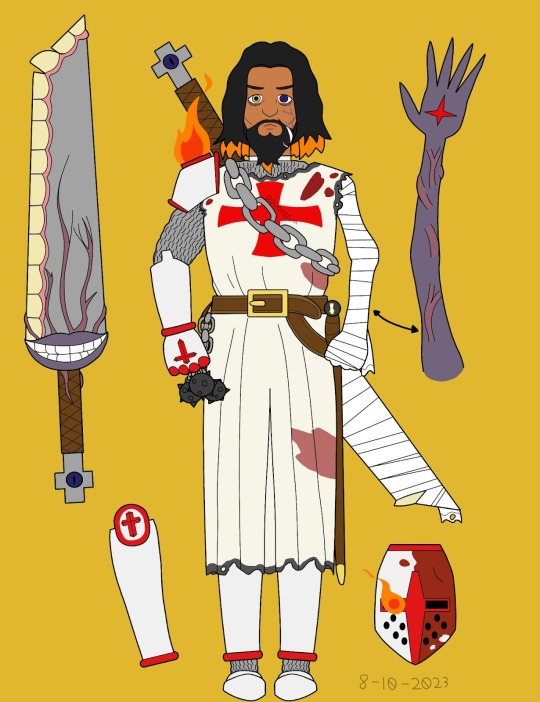


7 notes
·
View notes
Text

Hugues:
Funniest little mofo ever. He hated his father so much that when his father went to war, he just raised his own army to pillage his father's possessions.
Jean Ier:
First and only king of France to have reigned from his birth to his death! That's a total of five days.
6 notes
·
View notes
Text
Petites Histoires du Monde
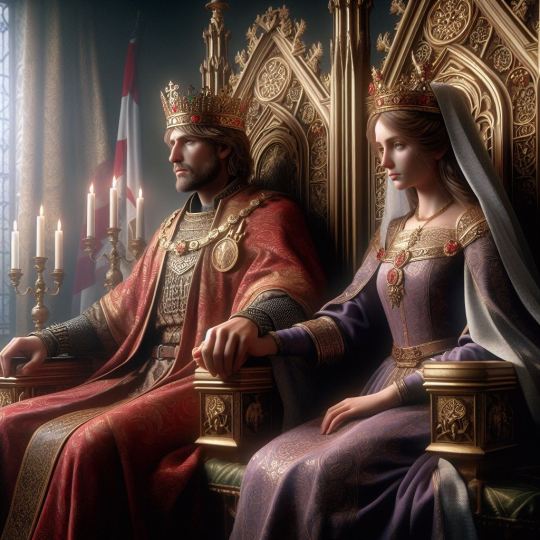
Listes des personnes et des OC pour l'instant :
- Baudouin IV de Jérusalem (5 histoires). (Plus à venir. )
Il est souvent associé à Alix de Tripoli, personnage fictif qui est la fille unique de Raymond III de Tripoli et qui a grandi à Jérusalem. Alix est douce, gentille, mais aussi intrépide et courageuse. Baudouin et Alix s'aiment infiniment, mais ils savent tous les deux que leur amour est impossible.
Mini-série : Guérison. Baudouin est guéri de la lèpre et décide quoi faire de sa vie. (À venir)
- Édouard Ier d'Angleterre (3 histoires) (Plus à venir. )
Il est souvent associé à sa femme Éléonore de Castille. Leur amour est inspirant et unique. Un OC peut apparaître également sous la forme d'Aliénor de Mercoeur, qui est la dame de compagnie et meilleure amie de la reine d'Angleterre.
Mini-série : Seconde Guerre des Barons avec le point de vue d'Henry III, Éléonore de Provence, Éléonore de Castille, Richard de Cornouailles et lord Édouard sur la bataille de Lewes de 1264. (Publié)
- Bohémond de Tarente (3 histoires) (Plus à venir. )
Bohémond est souvent associé à Alix de Sicile, une OC fictive qui est son épouse. Ils mettent du temps à se cerner l'un l'autre, mais après avoir découvert que sa femme n'est pas qu'une jolie chose à son bras, il est son plus fervent admirateur.
Mini-série : Chefs de la première croisade avec Godefroy de Bouillon, Baudouin de Boulogne, Hugues de Vermandois, Raymond de Saint-Gilles, Etienne de Blois, Robert de Flandres, Robert de Normandie, Adhémar de Monteil, Tancrède de Hauteville et bien sûr Bohémond. (En cours)
Personnages sans lien avec Bohémond de Tarente, Édouard Ier et Baudouin IV ou une mini-série.
- Louis IX de France, Saint-Louis (1 histoire)
- Édouard II d'Angleterre (À venir)
- Alphonse de Poitiers et sa femme Jeanne de Toulouse (À venir)
- Sybille de Jerusalem et Guy de Lusignan (À venir)
- Agnès de Courtenay (À venir)
- Amaury II de Jérusalem ( À venir)
- Aliénor d'Aquitaine ( À venir)
- Henry II d'Angleterre ( À venir)
- Richard cœur de Lion (À venir)
- Jean Sans Terre ( À venir)
Et bien d'autres....
Si vous voulez en voir plus n'hésitez pas à proposer des personnes ou des événements.
#fanfic#history medieval#medieval history#bohemond i of antioch#king baldwin#baldwin iv#edward ii#Edward I#booklr#france#england#eleonor of castile#eleanor of aquitaine#plantagenet#plantagenets
6 notes
·
View notes
Video
Wallpaper #59 by Laurent Quérité
Via Flickr:
36 - Porsche 991 Cup 4,0 Roscar GT Challenge 911 Impact Racing Team Pilote : Hugues VANDEWOESTYNE Pilote : César VANDEWOESTYNE Circuit de Ledenon Ledenon Gard France IMG_0588
7 notes
·
View notes
Text
Loyal brothers
The Capetian kings found their brothers no more difficult than their sons. The exceptions were the brothers of Henri I, Robert and Eudes, but thereafter the younger Capetians developed a tradition of loyalty to their elders. Robert of Dreux, the brother of Louis VII, who was the focus of a feudal revolt in 1149, was only a partial exception, for at that date the king was still in the East, and the real object of the hostility was the regent Suger. By contrast, Hugh of Vermandois was described by contemporaries as the coadjutor of his brother, Philip I. St Louis's brothers, Robert of Artois, Alphonse of Poitiers, and Charles of Anjou, never caused him any difficulties, and the same can be said of Peter of Alençon and Robert of Clermont in the reign of their brother Philip III. Even the disturbing Charles of Valois, with his designs on the crowns of Aragon and Constantinople, was always a faithful servant to his brother Philip the Fair, and to the latter's sons. The declaration which he made when on the point of invading Italy in the service of the Pope is revealing:
"As we propose to go to the aid of the Church of Rome and of our dear lord, the mighty prince Charles, by the grace of God King of Sicily, be it known to all men that, as soon as the necessities of the same Church and King shall be, with God's help, in such state that we may with safety leave them, we shall then return to our most dear lord and brother Philip, by the grace of God King of France, should he have need of us. And we promise loyally and in all good faith that we shall not undertake any expedition to Constantinople, unless it be at the desire and with the advice of our dear lord and brother. And should it happen that our dear lord and brother should go to war, or that he should have need of us for the service of his kingdom, we promise that we shall came to him, at his command, as speedily as may be possible, and in all fitting state, to do his will. In witness of which we have given these letters under our seal. Written at Saint-Ouen lès Saint-Denis, in the year of Grace one thousand and three hundred, on the Wednesday after Candlemas."
This absence of such sombre family tragedies as Shakespeare immortalised had a real importance. In a society always prone to anarchy the monarchy stood for a principle of order, even whilst its material and moral resources were still only slowly developing. Respectability and order in the royal family were prerequisites, if the dynasty was to establish itself securely.
Robert Fawtier - The Capetian Kings of France
#xii#xiii#xiv#robert fawtier#the capetian kings of france#henri i#robert i de bourgogne#louis vii#robert i de dreux#abbé suger#philippe i#hugues de vermandois#louis ix#robert i d'artois#alphonse de poitiers#charles i d'anjou#philippe iii#pierre d'alençon#robert de clermont#philippe iv#charles de valois
7 notes
·
View notes
Photo
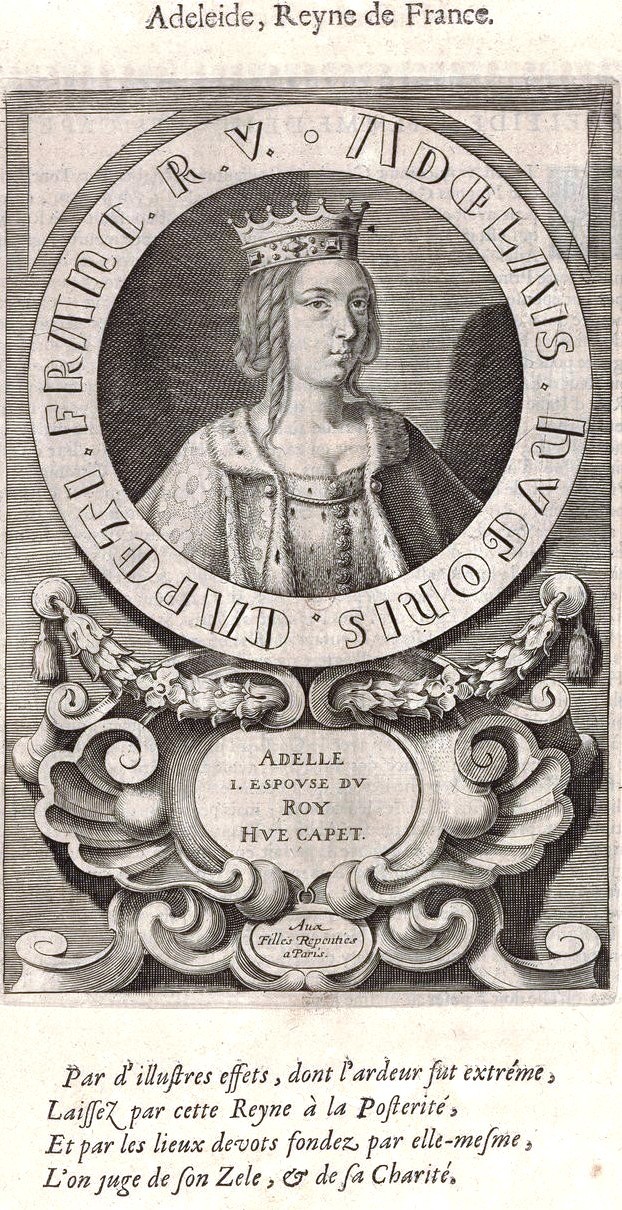
Adelaïde, Reine de France, deuxième femme de Hugues Capet.
6 notes
·
View notes
Text
Here's some Templars whose research distracted me very well from the happenings in Paris and the fact I'm ordering food via phone to go out as little as possible. Okay. Here's what I found:


Transcript of the first and second page:
André de Montbard
was born on November 5th 1097. All we know is that he had richt even noble parents and that he was the fifth Grand Master and founder of the Templars.
Bertrand de Blanchefort
was the sixth Grand Master and was born sometime in 1109. He fostered the Templars as guardians of travelling Christians rather than brutes despite their weaponry. For three years he was a prisoner of was and went on one single expedition, declining a second.
Philip of Nablus, also: of Milly
actually a Jerusalem-born man in 1120. Wasn't too fond of being Grand Master yet submitted to Almaric pressuring him. He became seventh Grand Master and resigned in 1171.
Ode de St. Amand
was the eigth Grand Master born in 1110. He was captured by Saladin in the battle of Morj Ayyun, to the dismay of his fellows since he was described as a headstrong guy, leading in both praise and resentment and being a valuable member.
Arnold of Torroja
born in wherever and whenever, he was the ninth Grand Master at the ripe age of 70. He worked on Hispaniola in the Reconquista. His capability in negotiating even with Saladin made him an important GM, so important that his tomb was only discovered in 2018, very well hidden from others.
Gerard de Rideford
hid his birth year but died in 1189. Used to be the 10th Grand Master of the Templars. He used king Henry II's money to bring more troops to Jerusalme. Apparently he was pretty beloved, as Saladin offered his life for a peaceful surrender, which succeeded and he was released to Tortosa.

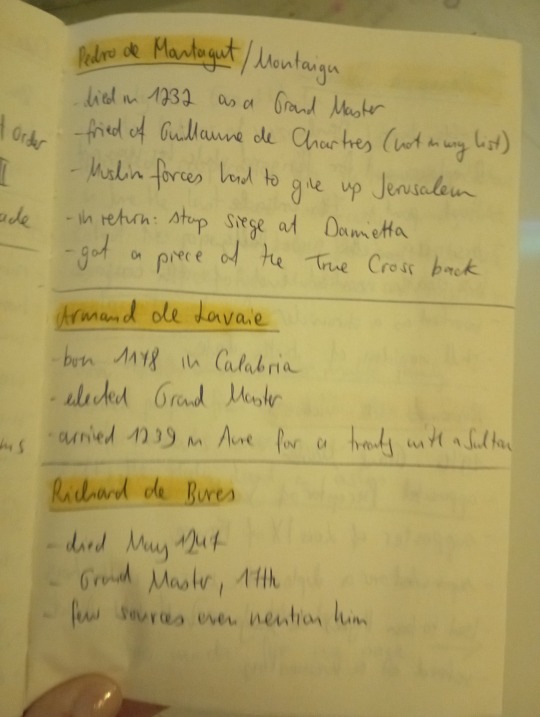
Transcript of the third and fourth page:
Robert de Sablé
was born a lord of Sablé in 1150. Not only was he the eleventh Grand Master but also member of the Valiant Order. Helped Henry Hunior revolt against his daddy Henry II and also convinced Islamic troops to retreat in the third crusade.
Gilbert Erail (or Horal)
born whenever, died in 1200. He was the twelfth Grand Master and aspired to wage peace, not war, in between Christians and Muslims.
Philippe de Plessis
castle-forn or rather fortress-born in France in 1165. Was the thirteenth Grand Master of the Templars and had semi-good relationships to the Hospitallers (kinda like the Templars but evangelican Maltesers). Suggested a peace treaty with Malek Adhel.
Pedro de Montagut (or Montaigu)
died in 1232 while still being a Grand Master and ways a friend of Guillaume de Chartes, whoever that was. Made a deal with the Muslims: they gave up Jerusalem while the Templars stopped the siege of Damietta. Most importantly he got a piece of the True cross, I wonder if that's still somewhere?
Armand de Lavaie
he was born in 1178 in Calabria and elected Grand Master. Death is really unclear, some say he died in battle, others say he survived capture. In 1239 he arrived in Acre for a treaty with a sultan.
Richard de Bures
is somewhat of a ghost since all we know is he died in May 1247 and was the seventeenth Grand Master.

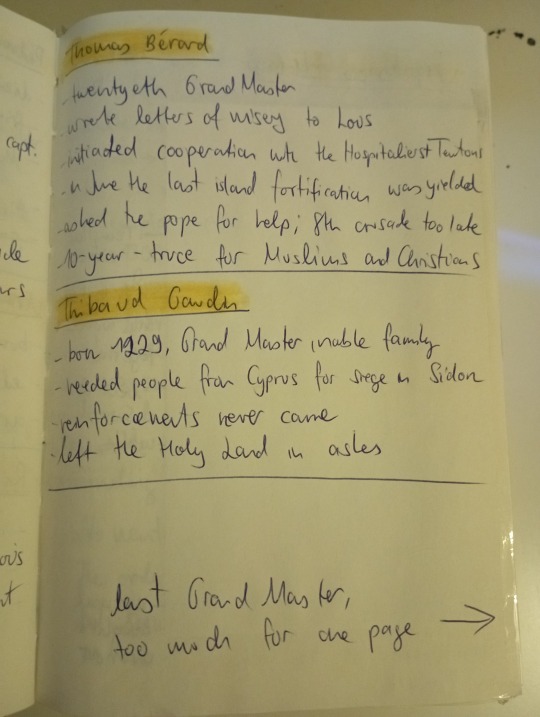
Transcript of the fifth and sixth page:
Guillaume de Sonnac
a noble-born Frenchman whose birth date is unclear. Took part in the successful 7th crusade. He worked as a chronicler for the Templars, lots of information we know on them cites him as source. He replaces Périgord while this guy was captured, and his death was the end of the 17th crusade.
Renaud de Vichiers
was the 19th Grand Master of the Templars and the preceptor of Saint Jean-d'Acre. He was having issues with Hugues de Joug and had to throw him out of the order to stop their fight. Lois IX of France was a supporter and financer of Renaud, but he again fought with him and parted int he end over a diplomatic mission. He retired in a monastery, and if not alone, he argues to this day.
Thomas Bérard
wrote letters of misery to king Lois despite being twentieth Grand Master and somewhat respectable. He initiated a cooperation with the Hospitaliers Teutons and yielded the last island's fortification in June. Asking the Pope for help he waged the 8th crusade which became the last since Lois died. His most significant win: a 10-year-truce for Muslims and Christians.
Thibaud Gaudin
another man with rich parents boen in 1229 was the 22nd Grand Master of the Knights Templars. Demanding people from Cyprus for a siege in Sidon wasn't successful since the reinforcements never came, so he left the Holy Land in ashes.
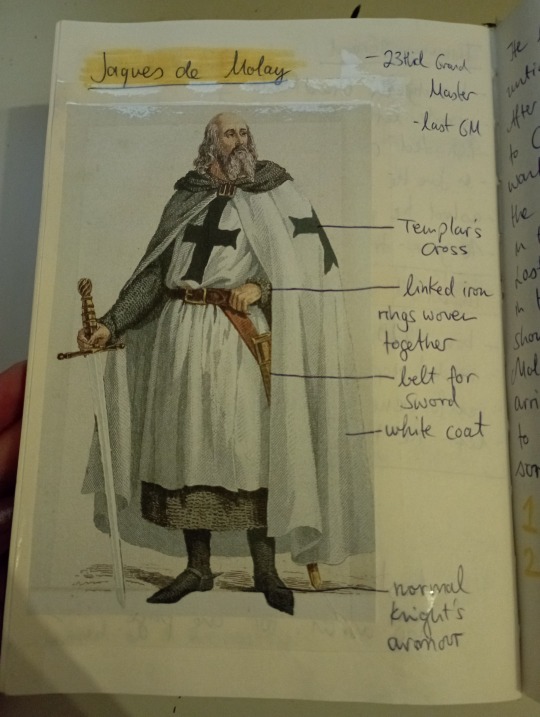
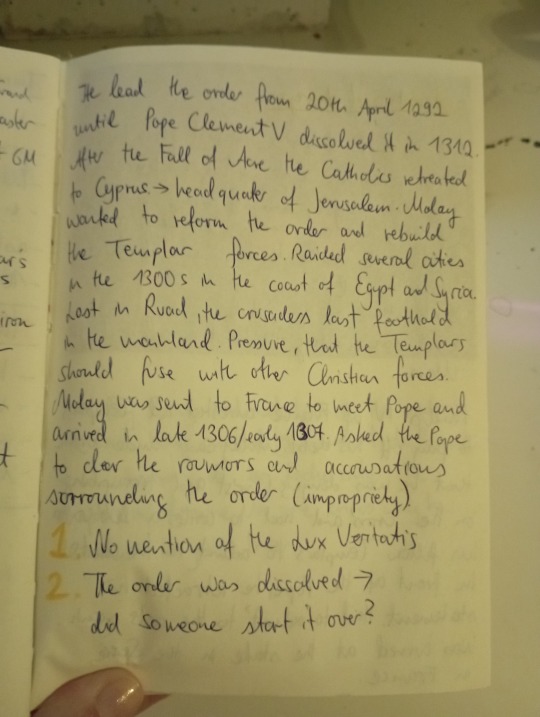
That's Jaques de Molay, the 23rd and last of the Knights Templar's Grand Masters. I found a painting depicting him and it showed me how Templars looked like, from an ancient point of view, not one in Hollywood. Templars were called Knights Templars and would own and wear a normal knight's armour during the day. Above that, they had a white cloak with a black Christian cross on it, and a leather belt in which they could carry their swords in.
Molay lead the order from the 20th April of 1292 until Pope Clement V was having none of it and dissolved the order in 1312. After the fall of Acre the Catholics retreated to Cyprus, the headquater of Jerusalem. He wanted to obviously keep the order and tried to rebuild the Templars, raiding several cities in the 1300s at the coast of Egypt and Syria (not very Christian huh?). They lost in Ruad and had to retreat to the shore, always feeling the pressure to collaborate with other Christian forces. Molay was sent to France to meet up with the Pope and arrived in 1306 or 1307. He even asked the Pope to wipe the name of the Knights templars clear and adress the rumours and accousations.
What I gathered from all of this?
There is no mention of the Lux Veritatis and the order was dissolved and never officially continued. Now, theory: what if someone started over and renamed the club into the LV? Could that be possible? I mean, there's plenty of ties to France...
#tomb raider angel of darkness#traod#classic tr#tomb raider#angel of darkness#journal#aod#lara craft#tomb raider series
2 notes
·
View notes
Text
¿Historias cortas para no dormir y así no tener pesadillas? La Web del Surrealismo Hughes Gillet (1968-)
Hugues Gillet nació en Francia y desde 1992 se dedica a la pintura.

Ha expuesto sucesivamente en Montecarlo, patrocinado por el pintor Jean Carzou en el marco del Premio de Arte Contemporáneo, en Ablon sur Seine, en Rouen en varias galerías y en el Salon des Independants (1993-2000), en París en el Studio Imagen
También ha tenido exposiciones en varias otras galerías y salones en Francia, especialmente en París, en el Musée de l'Imaginaire ubicado en el Château de Ferrières (Seine et Marne France), en Mónaco, en Japón en Tokio y Kyoto, en Viena. en Austria, en Baviera, Portugal, Lisboa, Coimbra y Toledo en España.
También es el fundador con el escultor Bruno Baratier y Kunihiko Kanoh de la asociación internacional Artis Fictae Turma.dedicado al Arte Fantástico y Visionario Contemporáneo Francés e Internacional
#Hugues Gillet nació en Francia y desde 1992 se dedica a la pintura.#¿Historias cortas para no dormir?#¿Esta es la imagen y algunos datos (O no) la “Historia” la pones tú? ¡La tuya! ¿Lo harás...?#surrealismo
3 notes
·
View notes
Photo

Les béguines et la littérature au Moyen-Âge
En France, c'est Saint Louis qui apportera une protection particulière aux béguines : de retour de la 7ème croisade, il rencontra Hugues de Digne, frère franciscain, aux environs de Hyères, le 17 juillet 1254. Celui-ci lui enjoignit de veiller sur les pauvres comme à la simplicité de sa vie. Louis IX se fera protecteur des ordres mendiants toute sa vie durant. Hugues de Digne avait lui-même une soeur béguine, Sainte Douceline, autour de laquelle s'était constitué un béguinage, les "Dames de Roubaud". L'une de ses plus proches disciples, Philippa Porcelet, écrivit en langue occitane du XIIIème siècle (1297), une vie de Sainte Douceline, considérée par Ernest Renan comme le chef-d'oeuvre en prose de la première littérature provençale.
(via Les béguines et la littérature au Moyen-Âge | Le blog de Gallica)
4 notes
·
View notes